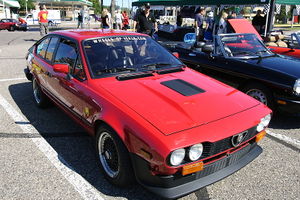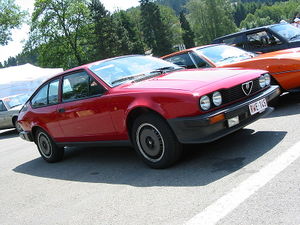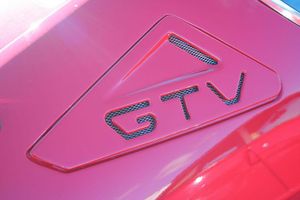Alfa Romeo Alfetta
| 280px | |
| Alfa Romeo Alfetta | |
|---|---|
| Manufacturer | Alfa Romeo |
| Parent company | |
| Aka | Gold Leaf model was also sold as the Alfetta 159i in some markets |
| Production | 1972–1987 |
| Assembly | Arese, Milan, Italy Rosslyn plant, South Africa Brits, South Africa |
| Predecessor | None |
| Successor | Alfa Romeo 75 Alfa Romeo GTV (1995) |
| Class | |
| Body style | 4-door sedan 2-door coupe |
| Layout | FR layout |
| Platform | |
| Engine | 1.6 L I4 1.8 L I4 2.0 L I4 2.0 L I4 turbo 2.0 L I4 turbodiesel 2.4 L I4 turbodiesel 2.5 L V6 2.6 L V8 (limited edition) |
| Transmission | |
| Wheelbase | 2510 mm 2400 mm (GT/GTV/GTV6) |
| Length | 4270 mm |
| Width | 1670 mm |
| Height | 1435 mm |
| Fuel capacity | 49 L |
| Ground clearance | |
| Transmission | 5-speed manual 3-speed ZF automatic |
| Weight | 1000 kg (GTV) 1210 kg (GTV6) |
| Top speed | |
| Related | |
| Similar | Lancia Beta Peugeot 504 Audi 100 |
| Related | Alfa Romeo Giulietta (nuova) FNM-Alfa Romeo 2300 (Rio) |
| Designer | Berlina:Giuseppe Scarnati GT:Giugiaro/Alfa Romeo |
Alfa Romeo GTV redirects here. For 916 series GTV see Alfa Romeo GTV & Spider
The Alfa Romeo Alfetta was an executive saloon car and fastback coupé produced from 1972 until 1984 by Alfa Romeo. It was popular due to its combination of a modest design with powerful engines, selling over 400,000 units until the end of its production run, but in the final years its sales were down due to Alfa Romeo's reliability problems that plagued the company through the late 1970s and early 1980s.
Designed by Giorgetto Giugiaro, the Alfetta introduced a new drivetrain layout to the marque. Clutch and transmission were housed at the rear of the car, together with the differential for a more balanced weight distribution, as used on the Alfetta 158/159 Grand Prix cars. The suspension relied on double wishbones and torsion bars at the front and a de Dion beam at the rear. The Alfetta was renewed in 1979 with a revised frontend, new wheel rims and new lights, as well as a Diesel version.
It was available with two four-cylinder DOHC engines with two valves per cylinder and a turbo Diesel engine supplied by VM Motori. The 1.6 and 1.8 L base models had two double-barrel carburettors, while the 2.0 DOHC received fuel injection in 1979. The Diesel initially had 2.0 L, but was increased to 2.4 L in 1982.
A final facelift was added in 1984, when the company changed the car's name to Alfa 90, to conform to its new naming system, which included the Alfa 33 and 75.
The Alfa Romeo Alfetta became well known throughout the world since it was Italian Prime Minister Aldo Moro's official escort car, when, in 1978, he was first kidnapped, then killed, by the Italian Terrorist left-wing organization The Red Brigades. A fictionalised account of these events was produced as a critically well regarded Italian film , The Advocate, which also heavily featured Alfettas of all types, from Caribieneri 'Short Nose . Round Light' through to the Prime Minister's own 'Long Nose Square Light' 2000 Super Saloon.
| Version | Years | Produced |
| Alfetta | 1972-74 | 104,454 |
| Alfetta (RHD) | 1972-78 | 2,011 |
| Alfetta 1.8 | 1975-83 | 67,738 |
| Alfetta 1.6 | 1975-83 | 77,103 |
| Alfetta 2000 | 1976-77 | 34,733 |
| Alfetta 2000 (RHD) | 1977 | 1,450 |
| Alfetta 2000 L | 1978-80 | 60,097 |
| Alfetta 2.0 | 1981-84 | 48,750 |
| Alfetta 2000 LI America | 1978-81 | 1,000 |
| Alfetta 2000 Turbodiesel | 1979-84 | 23,530 |
| Alfetta Quadrifoglio Oro | 1982-84 | 19,340 |
| Alfetta CEM | 1983 | 991 |
| Alfetta 2.4 Turbo Diesel | 1983-84 | 7,220 |
| Total Note: Unofficial figures |
448,417 | |
Design and dynamics
The rear transaxle found on the Alfetta and derivatives- GTV, 90 and 75- provided these cars with excellent weight distribution. This resulted in excellent handling, which some experts believe these were among the best-handling saloon cars of their time. Unlike most rear-wheel drive cars, the transaxle meant there was no transmission tunnel linking the gearbox to the rear axle- thus helping interior space.
GT, GTV and GTV6
For information about the GTV (916) see Alfa Romeo GTV & Spider
The Alfetta was the base for the GTV, a fastback coupé version of the saloon, introduced in 1974 as Alfetta GT, initially available only with the 1.8 litre (1779 cc) version of the Alfa DOHC four. For 1976, with the final phasing out of the earlier 105 Series 1.3 and 1.6 litre coupes (GT 1300 Junior and GT 1600 Junior) and the 2.0 litre 105 series 2000 GTV, the Alfetta GT became a range, also available with the 1.6 litre (1570 cc) and 2.0 litre (1962 cc) versions of the same engine as the Alfetta GT 1.6, Alfetta GT 1.8 and Alfetta GTV 2000. The GTV designation was initially reserved for the 2.0 litre top version.
In 1979, some minor revisions, including a revised engine with new camshaft profiles and a change to mechanical-and-vacuum ignition advance, saw the 2.0 litre redesignated the Alfetta GTV 2000L. Autodelta also produced a limited edition turbocharged model, named Turbodelta, for FIA Group 4 homologation. This version used a KKK turbo which pushed power up to 175 PS (129 kW). The car also received a modified suspension layout. This was the first Italian production car with a turbocharger.
The styling of the GTV, while distinctive, can be seen to share many design features derived from the Montreal supercar, as translated down to a simpler and thus more marketable vehicle. Examples of this are the bonnet line, which while briefer, still has 'scallops' for the headlights, and the tail light clusters which resemble those of the Montreal. The door shape is similar, and in a sharing of parts, both vehicles employ the same door handles.
In 1981, the GTV received a restyling, with grey plastic bumpers and all matt-black trim replacing bright stainless steel, the 1.6 litre and 1.8 litre versions were discontinued and the Alfetta 2000 GTV became the base coupé model as the Alfa GTV 2.0. The Alfetta name was dropped, but the two-litre coupé retained its type designation of 11636 for left hand drive and 11637 for right hand drive. 15 inch alloy wheels were now standard, as opposed to the earlier cars' 14 inch pressed steel or optional 14 inch alloy.
GTV6
For information about the Current model GTV see Alfa Romeo GTV & Spider
Later in the same year, the GTV-6, a version of the GTV with the SOHC V6 2.5 L engine from the Alfa 6 luxury sedan, was released. As a result the hood received a bulge to clear the top of the intake and became its most pronounced feature. With Bosch fuel injection instead of the six downdraught Dell'Orto carburettors in the early Alfa 6 installation, the V6 was much easier to start and retained its state of tune much better. The V6 received rave reviews from the motoring press, which had previously lambasted the same engine in the Alfa 6 because of the carburettor problems. It found its true home in the GTV-6 where it could stretch its legs better than in the less sporting Alfa 6 sedan, including winning the European Touring Car Championship an unprecedented four years in succession (1982-85), the British Touring Car Championship in 1983 at the hands of Andy Rouse, as well as many other racing and rallying competitions. The fuel injection installation eventually made it into the second series of the Alfa 6 as well. The GTV went through a number of revisions, including a new gear ratios and an updated interior in 1984.
A grey GTV6 is featured for a short period in the James Bond movie Octopussy. Bond steals the parked car while its owner uses a pay phone booth and makes haste towards Octopussy's Circus.
The GTV6 was driven to victory by Greg Carr and Fred Gocentas in the 1987 Australian Rally Championship.
South African models were first assembled at Automaker's Rosslyn plant, located outside Pretoria. These early, 1973 models, were manufactured alongside Datsuns. From 1974 South African Alfetta's were manufactured at Alfa Romeo's own Brits plant. South Africa was one of two markets to have a turbocharged GTV6, with a Garrett turbocharger and a NACA intake. An estimated 750 were assembled before all production ceased in 1986. The South African market also introduced the 3.0 L GTV-6, predating the international debut of the factory's 3.0 L engine in 1987. Approximately 200 were built in South Africa for racing homologation. To this day, the GTV-6 remains the quintessential Alfa Romeo for South Africans.

For the U.S. market two limited production GTV-6 models stand out. The Balocco (named after the famous Balocco test track in Italy) in 1982 with a production run of only 350 cars. The Balocco was available only in red with sunroof and black interior, leather wrapped steering wheel and red piping on the seats. There were also two green Quadrifoglio badges fixed on the rear quarter trim pieces above a badge with the "Balocco SE" designation. A plaque inset in the glove box door designated the number of the car out of the series of 350 (XXX of 350) And the GTV-6 2.5 Maratona, of which only 150 were built. The Maratona model included a more aggressive aerodynamic trim package, lightweight Speedline wheels, clear engine view port, sunroof, wood steering wheel and shift knob, rear louvers and Carello fog lamps. All 150 cars were available only painted Silver and with a black leather interior; and came with "Maratona" badging on the rear decklid, front fenders and glove box door. (The most notable feature of the Maratona, its aerodynamic kit, was also available as a dealer-installed option on other GTV-6 models.)
| Alfa Romeo GTV6 Callaway Twin Turbo |
|---|
Callaway Cars, famous for their modified Camaro, Impala SS and Corvette offerings modified between thirty and thirty-six (depending on whether one "counts" those cars with Callaway components which were not assembled by Callaway but, instead, had those components fitted by Alfa Romeo dealers) GTV-6s between 1983 and 1986, of which the first five (the cars produced between 1983 and 1985; these were sold and titled as 1985 model year cars, save for the first prototype which was sold and titled as a 1984) were prototypes. Callaway "production models" were otherwise listed as from the 1986 model year. In addition to numerous small component upgrades, the Callaway GTV-6s included a somewhat revised suspension (most notably eschewing the metric Michelin TRX wheel/tire combination—then standard on the GTV-6—in favor of Pirelli or Goodyear tires on conventionally-sized BBS, Speedline or OZ lightweight alloys), improved brakes and, most importantly, a twin-turbocharger system, boosting performance to exotic levels. A different twin turbo GTV was also built briefly for the Australian market.
Alfetta GT and GTV Racing Versions by Autodelta
Recing versions of the Alfetta GT and GTV were built by Autodelta, initially with the normally aspirated engine from the earlier GTAm racer based on the 105 series coupe, for homologation under FIA Group 2. In this form they were rallied with moderate success in 1975, winning the Elba and Costa Brava rallies overall, as well as winning the Group 2 category in the World Rally Championship's Corsican event. The next year Autodelta shifted its focus to circuit racing the Alfettas, which won the under 2.5-liter Group 2 division of the European Touring Car Championship, scoring a remarkable second place overall at the 24 hour race at Spa-Francorchamps, as well as an overall win in the ETC race at Vallelunga. Despite such results, Autodelta's efforts with the Group 2 Alfetta were desultory, and ended prematurely. At a single rally at the end of the 1975 season, Autodelta also rallied an Alfetta GTV with a 3.0 litre V8 engine, derived from the 2.6 litre V8 of the Alfa Romeo Montreal coupé and sharing the same mechanical fuel injection by Spica. It had been suggested to produce 400 roadgoing versions of this model for homologation but this plan was abandoned as well.
In 1980 the Alfetta GTV Turbodelta was already homologated in FIA Group 4, since the required number of production cars had been built. A racing version was campaigned in rallies, but once more the effort was abandoned after a single season, despite scoring a win at the Danube Rally.
Engines
| Model | Engine | Volume | Power | Torque | Note |
|---|---|---|---|---|---|
| 1.6 | I4 | 1,590 cc | 109 PS (80 kW) @5600 rpm | 142 Nm @4300 rpm | |
| 1.8 | I4 | 1,779 cc | 124 PS (91 kW) @5500 rpm | 167 Nm @4400 rpm | |
| 2.0 | I4 | 1,962 cc | 124 PS (91 kW) @5300 rpm | 175 Nm @4000 rpm | |
| 2.0 | I4 | 1,962 cc | 132 PS (97 kW) @5400 rpm | 178 Nm @4000 rpm | |
| 2.0 Turbo | I4 | 1,962 cc | 150 PS (110 kW) @ 5500 rpm | 231 Nm @3500 rpm | GTV 2000 Turbodelta |
| 2.0 Turbodiesel | I4 | 1,995 cc | 81 PS (60 kW) @4300 rpm | 162 Nm @2300 rpm | |
| 2.4 Turbodiesel | I4 | 1,995 cc | 95 PS (70 kW) @4300 rpm | 196 Nm @2300 rpm | |
| 2.5 V6 | V6 | 2,492 cc | 160 PS (118 kW) @5600 rpm | 213 Nm @4000 rpm | GTV6 |
| 2.5 V6 Twin Turbo | V6 | 2,492 cc | 230 PS (172 kW) @5600 rpm | 332 Nm @2500 rpm | GTV6 Callaway |
| 2.6 V8 | V8 | 2,594 cc | 200 PS (147 kW) @6500 rpm | 270 Nm @4750 rpm | GTV 2.6i |
External links
| <- Previous | Alfa Romeo Automobiles S.p.A., a subsidiary of the Fiat S.p.A. since 1986, car timeline, 1980s-present | ||||||||||||||||||||||||||||||
| Type | 1980s | 1990s | 2000s | ||||||||||||||||||||||||||||
| 0 | 1 | 2 | 3 | 4 | 5 | 6 | 7 | 8 | 9 | 0 | 1 | 2 | 3 | 4 | 5 | 6 | 7 | 8 | 9 | 0 | 1 | 2 | 3 | 4 | 5 | 6 | 7 | 8 | 9 | ||
| Supermini | Junior | ||||||||||||||||||||||||||||||
| Small family car | Alfasud | 33 | 145/146 | 147 | 149 | ||||||||||||||||||||||||||
| Arna | |||||||||||||||||||||||||||||||
| Compact executive car | Alfetta | 75 | 155 | 156 | 159 | ||||||||||||||||||||||||||
| Nuova Giulietta | |||||||||||||||||||||||||||||||
| Executive car | Alfa 6 | 90 | 164 | 166 | 169 | ||||||||||||||||||||||||||
| Coupé | Sprint | GTV (916) | GT | ||||||||||||||||||||||||||||
| GTV | Brera | ||||||||||||||||||||||||||||||
| Cabriolet | Spider (916) | Spider (939) | |||||||||||||||||||||||||||||
| Sportscar | SZ/RZ | ||||||||||||||||||||||||||||||
| Roadster | Spider | ||||||||||||||||||||||||||||||
| Supercar | 8C Competizione and Spider | ||||||||||||||||||||||||||||||
| Racing car | 179/182/183T/184T/185T | SE 048SP | |||||||||||||||||||||||||||||


